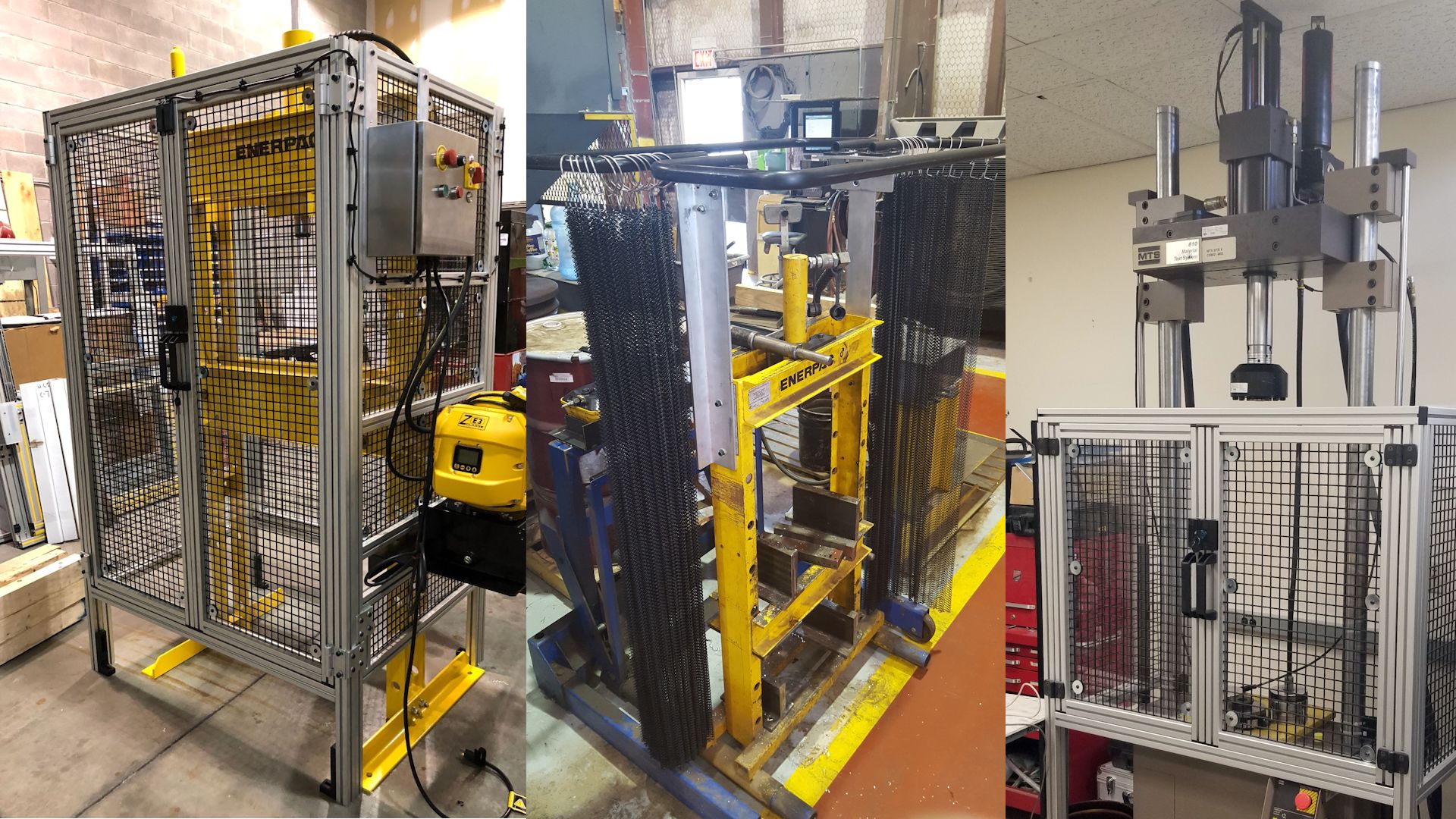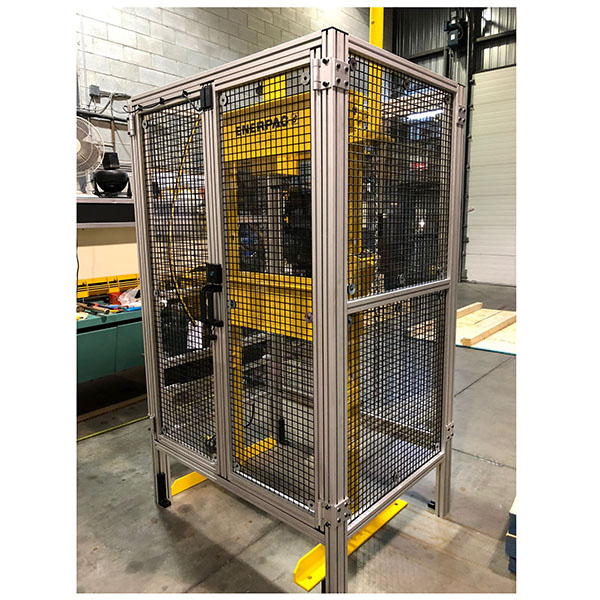H-Frame Hydraulic Press Hazards & Safeguarding Solutions
May 29, 2025 in Machine Safety Blog byEstimated reading time: 6 minutes

Why focus on H-frames?
The classic H-frame (four-column) hydraulic press is popular because it offers an open front, generous visibility with maximum daylight*, and high tonnage in a compact footprint. Those benefits create broad exposure zones and strong ejection paths, raising the stakes for operators and anyone walking past.
* I came across the technical term daylight while I was doing some research. Initially, I thought I was reading an article generated by AI. On the contrary, it refers to the maximum vertical space between the ram and the bed. Essentially, the vertical space determines the maximum size of the workpiece that the press can accommodate.
Key Dangers of H-Frame Hydraulic Presses
OSHA’s incident database records a steady stream of partial- and full-finger amputations caused by hands entering the die space during load, unload, or rework cycles. In 2021 alone, the OSHA database lists over a dozen cases with the “hydraulic press” keyword. These reports include accidents that lead to amputations, crushing, lacerations, fractures, and death.
Crushing & pinch points
The easy access of an H-frame press tempts operators to “just nudge” a part into alignment. Consequently, if a finger slips between the ram and workpiece, it only takes a split second to experience a crushing injury.
The fix is twofold: First, we must keep our hands out of the danger zone. We can do this with fixed or interlocked doors. Secondly, where open access is unavoidable, backstop them with dual-button controls that halt the stroke when a button is released.
Part or tool ejection
Misaligned workpieces can “squeeze out” under pressure, while a cracked punch or die can shatter like shrapnel. For instance, let’s take pressing bearings onto shafts or housings. The hydraulic press exerts many tons of force onto a relatively small area on the bearing surface and thus could cause the bearing to shatter. As a result of a slight imperfection, a crack, or misalignment, a tiny piece of material could project at hundreds of miles per hour towards a person in the vicinity.
OSHA logs include a vivid example titled “Employee operating hydraulic press is struck by ejected steel,” underscoring how far ejections can fly. Operators at the press face and pedestrians in adjacent aisles are equally exposed.
Guarding here concerns containment: floor-mounted mesh enclosures, ballistic curtains, or transparent polycarbonate shields absorb or deflect airborne parts without blocking the operator’s view.
High-Pressure Fluid
A pin-sized leak in a 5,000-psi hose can inject hydraulic oil deep into tissue before a person even feels the puncture.
These injuries can lead to compartment syndrome, infection, or amputation if not treated within hours. Prevention starts with hose management: replace lines at the manufacturer’s recommended intervals, shield them with abrasion-resistant sleeves, and route them away from sharp edges. During maintenance, always de-energize the system, bleed pressure to the tank, and wear cut-resistant gloves and a face shield.
Safeguarding Hydraulic Presses
Hydraulic presses are rarely safeguarded directly from the factory. However, suppose the factory does include safety guards. In that case, the press will add a metal mesh shield mounted flush to the hydraulic press frame. There are two issues with this type of hydraulic press safety solution.
- The metal mesh may only contain objects larger than the mesh opening.
- Flush-mounting the shield directly to the frame press only allows pressing objects the size of the bed width. Such a mounted shield is useless when pressing objects such as driveshafts.
Let me explain in more detail.
Prevention of Hydraulic Press Ejections
Here’s the thing: metal mesh is excellent as a machine guard to prevent unauthorized access. It’s not that great to avoid the ejection of particles and containing projectiles. The large openings between the wires allow for visibility, but also allow objects to pass through.
The example photo shows a safety guard surrounding a hydraulic press, featuring a PVC-coated steel mesh behind a polycarbonate layer. Any ejections from the press will initially hit the polycarbonate layer. The steel mesh absorbs some energy and transfers it to the frame.
Polycarbonate offers excellent visibility, and it’s an amazingly durable material. It’s a solid choice to prevent hydraulic press ejections if the frame holding the polycarbonate is solid.
Another type of ejection protection is steel mesh curtains. The open-air openings of the steel mesh are small enough to contain most ejections while still allowing good visibility through the curtain. An accidental ejection will hit the curtain and come to a quick stop. Whereas the polycarbonate will have minimal deflection, the steel mesh curtain could deflect significantly depending on the weight of the ejected object. However, even with a larger deflection, the mesh will stop the ejected object by absorbing most of the energy.
Interlocking the doors
Some jurisdictions mandate a complete enclosure around the hydraulic press, thus forcing operators to close the doors to use the machine. Furthermore, the door is monitored by an interlock switch, preventing machine operation if it is open. Consequently, this can be problematic for operators who must hold a part in place until the ram makes contact and secures it firmly.
However, we want to avoid any crushing pinch points. Holding a piece with one hand while using our other hand to control the hydraulic pressure is not optimal. First, we’re multitasking with our hands dangerously close to the RAM. Second, we have little control over the speed and pressure of the ram. One slight misalignment can cause a part to eject towards us.
A simple yet effective system developed by Ferndale Safety is a two-pressure hydraulic upgrade for presses. The way it works is that if a door is open, the machine continues to function but only at significantly reduced pressures. Just enough to hold a part, but not sufficient to crush a hand or eject material.
Conclusion
In summary, our goal with hydraulic presses is to prevent ejected material and minimize crushing hazards. Accidents can happen, but by adding barriers and other safety upgrades, we can significantly reduce the likelihood of someone getting hurt.
Want to safeguard your hydraulic presses?
Let us contact you! We can:
Fill out the form, and one of our safety experts will get in touch with you shortly.


